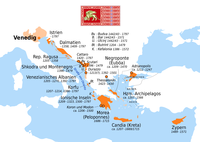Duchy of Durazzo (Republic of Venice)
| Duchy of Durazzo | |||||||||
|---|---|---|---|---|---|---|---|---|---|
| Overseas colony of the Republic of Venice | |||||||||
| 1205–1213 | |||||||||
|
Flag | |||||||||
Durazzo | |||||||||
| Historical era | Middle Ages | ||||||||
• Established | 1205 | ||||||||
• Treaty with Epirus | 1210 | ||||||||
• Captured by Epirus | 1213 | ||||||||
| |||||||||
| Today part of | Albania | ||||||||
The Duchy of Durazzo was a short-lived overseas colony of the
Background
During the late 11th and the 12th centuries, the city of Durazzo and its province (the "
Establishment and end
After the
At Durazzo, the Venetians met little opposition and one of the captains, Marino Vallaresso, was appointed governor of Durazzo with the title of
Although the Venetians had also laid claim to the mainland region of
Aftermath
In 1216, the Venetians turned to the new Latin Emperor, Peter II of Courtenay, to help them recover Durazzo. Peter landed at Durazzo in 1217, but although he may have briefly recovered the city, he was soon defeated and captured by Michael Doukas' half-brother and successor, Theodore Komnenos Doukas, and the city returned to Epirote hands.[10]
After the Epirote conquest, the city declined as an entrepôt for trade, as the Venetians moved their commerce to Ragusa instead.[6]
The city continued to change hands in the 13th and 14th centuries between the Greeks of Epirus and the restored Palaiologan Byzantine Empire, the Angevins of Naples, and the Serbs. Venice once again took possession of the city in 1392, holding it until it was conquered by the Ottoman Empire in 1501.[1]
References
- ^ a b ODB, "Dyrrachion", (T. E. Gregory), p. 668.
- ^ Angold 1997, pp. 129ff., 152.
- ^ Stephenson 2004, pp. 151–152, 159–160.
- ^ a b Nicol 1988, p. 155.
- ^ Nicol 1988, pp. 155–156, 161.
- ^ a b c d Robbert 1985, p. 426.
- ^ a b Nicol 1988, p. 161.
- ^ Nicol 1988, pp. 159–160.
- ^ Fine 1994, p. 68.
- ^ Fine 1994, pp. 112–113.
Sources
- ISBN 0-582-29468-1.
- Ducellier, Alain (1981). La façade maritime de l'Albanie au Moyen Age. Durazzo et Valona du ΧIe au XVe siècle [The Albanian Seaboard in the Middle Ages. Durazzo and Valona from the 11th to the 15th Century] (in French). Thessaloniki: Institute for Balkan Studies.
- ISBN 0-472-08260-4.
- ISBN 0-19-504652-8.
- ISBN 0-521-34157-4.
- Robbert, Louise Buenger (1985). "Venice and the Crusades". In Zacour, N.P.; Hazard, Harry W. (eds.). A History of the Crusades, Volume V: The impact of the Crusades on the Near East. University of Wisconsin Press. pp. 379–451.
- Stephenson, Paul (2004). Byzantium's Balkan Frontier: A Political Study of the Northern Balkans, 900–1204. Cambridge: Cambridge University Press. ISBN 0-521-77017-3.


